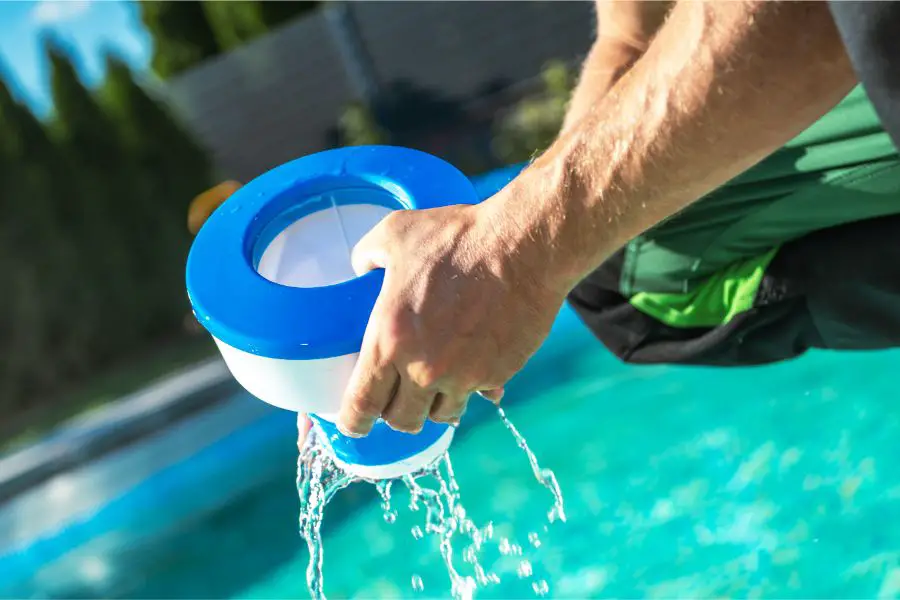Floating chlorine dispensers are a simple and easy way to add chlorine to your pool water without any effort. This simple device can dispense a controlled amount of chlorine into your pool over some time, so your pool will always be chlorinated.
So, this begs the question, do you leave the chlorine floater in the pool overnight?
Simply put, your chlorine floater should be kept in the pool nearly all the time, even at night. However, there are some key things to consider when leaving the floater in the pool.
In this post we’ll give you the skinny on leaving chlorine floaters overnight, and exactly when you should remove them. Let’s dive in!
Do You Leave the Chlorine Floater in the Pool Overnight?
In “most” cases, it’s recommended to leave the chlorine floater overnight.
Unlike automatic chlorinators, the chlorine floater is not connected to the pool’s plumbing. This means your pool pump does not need to be running for the floater to continue working.
In fact, your pool is most vulnerable to unwanted growth while the pump is off since the water will be stagnating. Having a chlorine floater will allow for continual addition of chlorine during this period.
Some pool owners that have an automatic chlorinator may also use a floater simply so that chlorine continues to be added even at night when the pump is off.
Additionally, if there’s a decent breeze at night, it will help keep the chlorine floater moving around the pool on its own. This will help distribute the chlorine around the pool as the pump is off.
When Not to Use the Chlorine Floater at Night
While we’ve just recommended that you keep the floater in the pool overnight, there’s an exception that you should at least consider –though, not a hard-and-fast rule!
If you are using a solar cover at night, it’s advised that you remove the chlorine floater from the pool. If you keep the floater under the cover, it won’t be able to move around and will result in a higher concentration of chlorine at a single spot.
If a portion of the cover sees prolonged exposure to high chlorine, it can eventually become brittle and damaged. Additionally, your liner could also become damaged due to concentrated chlorine if your floater is constantly pinned against the wall because of the solar cover.
Ultimately, the decision to keep the floating dispenser under the solar cover is unlikely to be catastrophic in nature. Many solar covers only last a couple of years anyways, in which the dispenser may not shave much off of it’s typical lifespan anyways.
If you decide you’d like to keep the floater in the pool with the cover on, try to rotate where the floater is each night to reduce potential damage. And, try to keep it away from the vinyl liner when putting the cover on to avoid damaging the pool itself.
You can also consider using a cheaper homemade solar cover, in which case damage from a chlorine floater would only put you out a few dollars. At this price-point, there’s really not much benefit in removing the floater from the pool when using the DIY cover.
Using a Winter Pool Floater
If you’ve ever opened your pool in the spring to find a green-tinged pond underneath the cover, it’s more than likely due to lack of residual sanitizer from the preceding months. This allows algae to start forming as the temperatures moderate in the spring while the cover is still on.
A winter pool floater, or time-release floater, is similar to the chlorine floater you’d use during the summer months. However, the winter floater will release chemicals slower to help prevent growth in the water over the dormant months.
Often the winter floaters are designed to hold non-chlorine chemicals that will provide similar benefits of chlorine. However, the chemicals are gentler than chlorine to help prevent damage to the pool during the winter.
You can also tie the floater to a string that is attached to the edge of the pool. This will allow you to reel it in periodically for a refill, if needed.
How to Use a Chlorine Floater
Chlorine floaters are simple to use. All you have to do is put the chlorine tablet in the floater and let it do its thing!
As a rule of thumb, you should be using at least a single three-inch chlorine tablet for every 5000 gallons of water in your pool. Floating dispensers are sold in various sizes to accommodate different pool volumes.
If it’s your first time chlorinating your pool, you should allow enough time for the free chlorine (FC) levels to reach a safe range of 2 – 5 ppm.
If you’re unsure how to use a chlorine floater, just follow these steps:
1 – Unlock the top of the chlorine floater, then insert the filter screen if your floater comes with it.
2 – Add the appropriate quantity of chlorine tablets to your dispenser based on the size of your pool.
3 – Seal the lid of the chlorine floater back on.
4 – Adjust the baffles on the chlorinator to set the dispense rate.
5 – Place the floater in the pool by completely submerging it under the water to release all air bubbles, then it should float to the surface.
6 – Attach the tether to the chlorine floater, so it doesn’t get sucked into the skimmer.
7 – After about three days, move the floater and tether to another section of the pool. This will prevent a single area of the pool from seeing elevated chlorine levels.
8 – Periodically check the tablets in the dispenser. If they become so small that they’re slivers, they could slip through the baffles and stain your liner.
9 – Check chlorine level regularly. You can experiment to find the ideal quantity of tablets and baffle positioning that provide your target FC level.
When to Remove the Chlorine Floater from the Pool
The most important time to remove the chlorine floater from your pool is if people will be swimming. The reason is that when the water splashes around, the chlorine floater is more prone to tipping over and losing its contents into the pool.
Additionally, if there are young children in the pool, a floating dispense could appear to be a fun toy. However, it would actually be very dangerous and toxic if they got their hands on it and started playing with the concentrated chlorine.
Conclusion
So, should you leave a chlorine floater in the pool overnight?
The answer is yes! You can leave the chlorine floater in the pool overnight, even with the pool pump turned off. This will keep your chlorine levels right where you need them to be with minimal oversight!
If using a solar cover, you may want to consider removing the dispenser when the cover is applied. This will help maximize the lifespan of the cover a bit.
You only need to take the chlorine floater out of the pool when people are using the pool, especially young kids who may see it as a toy.
Happy (Clean) Swimming!
Husband and father of three (actually, four if you include the pool). I’m an avid DIY-er and weekend warrior that enjoys taking up new projects around the house to help us maximize leisure right at home. I enjoy researching and sharing various tips, tricks and knowledge to help others make their home an oasis.

